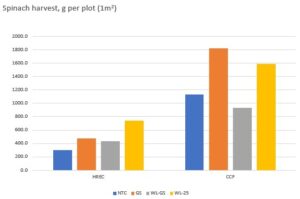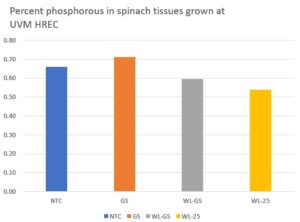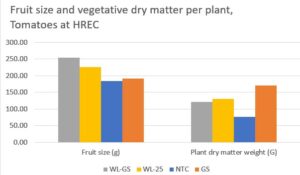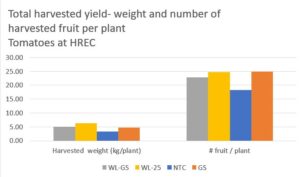Final report for ONE20-358
Project Information
This project addresses Northeastern vegetable farmers’ needs for sufficient production and yield, careful nutrient management and climate resiliency, by using a natural and potentially locally-produced item made from a waste product from sheep farms: pelletized raw wool. We conducted a study of how wool pellets affect nitrogen and phosphorus interactions with plants and soils, and how wool pellets are affecting soil moisture content.
The experimental design is a completely randomized design with four replications and three treatments. The trials were conducted in two Vermont locations, one at the UVM Horticulture Research and Education Center in Burlington and the other at Cedar Circle Farm and Education Center in East Thetford.
Incremental and final findings will be shared through field walks, print and web-based materials, video and social media with vegetable growers, shepherds, agricultural service professionals and other colleagues throughout the region.
This project seeks to:
- Determine if by using wool pellets as fertilizer providing N and K, spinach and tomato plants will utilize existing P in the soil.
- Determine whether the N in the pellets releases quickly enough for plants to utilize within the growing season.
- Understand whether wool pellets’ hygroscopic property can ameliorate the fluctuating extremes of precipitation on soil moisture levels during the growing season.
These are important questions for vegetable farmers. If we find that by using wool pellets for N and K, plants utilize existing soil P, that means less leaching into nearby waterways – a win for producers and the community. And if we find the pellets release N slowly enough so there is minimal, if any, runoff of excess, that too, is a win for both producers and the community. And if we find the hygroscopic properties of the pellets shows they can help absorb the moisture in excessive precipitation events, and then release in drier periods, this could help eliminate much of the need for irrigation and running electrical pumps, both promoting resilience and saving money for producers.
This project explores two agricultural issues: nutrient management on vegetable farms and utilization of wool, currently a waste product and cost for sheep producers to dispose of. We are specifically interested in how well pelletized raw wool performs for plant and soil needs of nitrogen (N) and phosphorous (P), and soil moisture content over time.
Vermont vegetable growers must carefully consider fertilizer use on their crops, seeking to balance productivity, costs, regulatory limits of N and P, and needs of their sites and soil type(s). Commonly used products, such as compost and chicken manure, often applied at rates that result in higher concentration of P than a crop’s ability to utilize it, result in water quality issues.
Meanwhile, Vermont shepherds contend with costs that currently do not contribute to their revenue. Shearing sheep is a necessary step in the husbandry of this small ruminant. Whether raised for meat or milk, an annual “haircut” is required for their health. Since much of the clip produced in the northeast is coarse wool, not suitable for value-added products that require softness like yarn or clothing, it has little value. Since 1994, the market price for raw wool has been dropping, and is now below the cost of shearing and the transport of it. A small percentage has the fine softness used for many small batch cottage industries, but generally, if not sold to the local wool pool collection, many simply pile it in a corner of their barn or haul it out to the woods to dump it.
Findings from a USDA Rural Development-funded project conducted from 2016 – 2019 indicate an opportunity to address these issues for both vegetable growers and shepherds with this natural, locally produced item. Analysis of wool pellets, reveals an NPK profile average of 9-0-4, supplying nitrogen, virtually no phosphorus, and contributing small amount of potassium. The nitrogen slowly releases due to physical properties of fibrous wool pellet’s slow breakdown. For many vegetable farmers in Vermont this is an ideal combination. Many are over their regulatory limit for P, and need a source of N that supplies the nutrient at a time a crop needs it. A slower N-release rate helps to avoid the risk of nitrate leaching and runoff before plants can utilize the nutrient. Additionally, fifty percent of the weight of wool is carbon and thus pellets may also provide an opportunity for farmers to sequester carbon through their choice of fertilizer by incorporating the wool pellets into the soil.
Trials conducted with three Vermont vegetable farms in 2019 indicated that wool pellets may, in some ways, have superior qualities to the commonly used peanut meal or compost. Wool’s hygroscopic quality means an ability to ameliorate climate/weather extremes that contribute to excessive or limited soil moisture content because it can absorb, hold and release moisture as well as nutrients, over time.
Cooperators
- - Producer
Research
Experimental Design
The experimental design is a completely randomized design with four replications of four treatments, including: non-treated control; grower-standard fertilization; wool pellet fertilization at 25lbs wool pellets per 100ft as recommended by the manufacturer; and wool pellet fertilization standardized to match N input of grower standard treatment. The experimental plots are 3.3 m sections of a single field bed, totaling 160 bed feet. Data were collected from 1 m sections within the center of each plot to minimize edge effects between treatments. All data are being analyzed for mean differences using one-way ANOVA (SAS v.9.3, Cary, NC) with fertilization treatment effects separately analyzed for each crop and site.
Field Description
This trial was conducted in two Vermont locations, one at the UVM Horticulture Research and Education Center (HREC) in Burlington and Cedar Circle Farm and Education Center (CCF) in East Thetford. The soil types in these locations are Adams and Windsor loamy sand and Hartland silt loam, respectively. The experimental design is a randomized complete block design with four replications and four treatments for both crops, spinach and tomatoes.
At each site, one bed each of spinach (Spinacia oleracea, cvr. ‘Kolibri’) and tomato (Solanum lycopersicum, cvr. ‘Skyway’) were grown for use in the trial. Both crops were seeded in the greenhouse for later transplanting into the research plot. Spinach was grown with three rows per bed with 0.3 m between rows and 0.3 m between plants within the row. The crop was managed using each grower’s standard practices for cultivation, weeding, and irrigation.
Tomatoes were planted in one single row per bed with 0.6 m between plants. Spinach was transplanted on 4 May and 26 April for CCF and HREC sites, respectively. Tomatoes were transplanted on 24 May at CCF, and on 23 June at HREC, with the later date selected in order to better align with the farm’s fall markets. In midsummer, tomatoes at CCF were infested with Colorado potato beetle (Leptinotarsa decemlineata) and organic pesticide treatments applied twice. Despite treatment, the plants were decimated by the insects, and no further work was done at that site with the crop.
The primary variable in this study was the type and/or amount or fertilizer used to provide supplemental nutrition to each crop beyond that supplied by the soil. Wool pellets were from Wild Valley Farm (Croyden, UT). Commercial fertilizer used in comparison treatments was Pro-Booster 10-0-0 (North Country Organics, Bradford, VT). Pro-Booster is a mixed, pelleted fertilizer blend certified for use in organic production systems. In addition to soil building through cover cropping and prior-season compost application, farm managers at both research sites use this product as their standard fertilizer to meet crop nitrogen needs beyond that provided through decomposition of soil organic matter (SOM).
Table 1. Experimental fertilizer treatments applied to tomato and spinach plots at two locations.
|
Treatment |
NTC |
GS |
WL-GS |
WL-25 |
|
Material |
none |
Pro-boost |
wool |
wool |
|
% N |
0 |
10% |
9% |
9% |
|
Target N, kg * ha-1 |
0 |
129 |
138 |
320 |
|
kg material * plot-1 |
0 |
0.59 |
0.53 |
1.36 |
Harvest and evaluation protocol
Spinach and tomatoes were harvested per the grower standard, and marketable yields were collected for both crops.
Agronomic sampling (soil, water, and fertilizer sources)
Pre-season and post-harvest soil samples were taken at 6-8" depths. Soil samples were submitted to the University of Vermont Extension soil analysis lab. Temperature and soil moisture were measured weekly using a soil thermometer and TDR soil moisture probe. Wool pellets were submitted to the University of Maine soil analysis lab and are found to have a 9-0-4 (NPK) mineral nutrient profile.
Analysis, summary, interpretation and presentation of any data gathered or program results, whether qualitative or quantitative.
Quantitative data included the following:
- Spinach was harvested at marketable full leaf maturity. All leaves were cut from the plant. Total yields were recorded by weight in grams. A subset of five plants per replicate was harvested, included in the overall weight, then dried for later calculation of dry matter weight and for evaluation of plant tissue mineral elements.
- Tomatoes were harvested weekly starting at 10 weeks and continued until the threat of frost. All red tomato fruit were stripped from the plant and separated into two categories, red and cull. Total yields (red and cull) and marketable fruit yields (red) were recorded by weight in kilograms.
- Two standard soil tests will be taken at each field trial location to measure pre and post season nutrient profiles of soil NPK and soil organic matter (SOM)
- Soil moisture content measured and recorded roughly bi-weekly throughout the crop growing season (May-October).
- Soil temperature was measured and recorded roughly bi-weekly throughout the crop growing season (May-October).
Statistical analysis of data used the following procedure:
- All data were analyzed for mean differences using one-way ANOVA (SAS v.9.3, Cary, NC) with fertilization treatment effects separately analyzed for each crop and site.
Due to a shift in personnel after one key personnel left UVM and another retired (but stayed on the project part-time), this project shifted into an undergraduate student-centered service learning project. Data in fall 2021 were collected by a team of students and summarized in December 2021. In January-February 2022, a team of student interns completed full statistical analysis of all project data for publication in a scientific journal . This research was published in May 2022 as:
Bradshaw, T. and Hagen, K. Wool Pellets Are a Viable Alternative to Commercial Fertilizer for Organic Vegetable Production. Agronomy. 2022; 12(5):1210. https://doi.org/10.3390/agronomy12051210.
Results presented in this report are taken from that paper.
General weather conditions during the growing season included relatively dry conditions at both sites for the majority of the growing season. Temperatures in summer were generally above normal at both locations, with 14 days at CCF and 10 days at HREC recording temperatures in excess of 30 °C during June and July, based on on-site weather monitoring. Pest incidence was low for spinach at both sites and for tomatoes at HREC, but Colorado Potato Beetles decimated the plants at CCF despite multiple applications of organic-certified pesticides. As a result, there was total crop loss at that site, and no results are presented in this report.
There were no differences in soil fertility at harvest for either crop or site, except for a biologically insignificant difference in aluminum at CCF. At HREC, there was a clear dose response for nitrogen and spinach crop yield, where increasing nitrogen was positively associated with increased yield. That response was not as clear at CCF- the lower rate wool treatment was similar to the non-treated control, and the other two treatments were similar but not statistically different. All yields were 2-3x greater at CCF than at HREC.
Few differences in mineral nutrient composition of spinach were observed at CCF. At HREC, differences were observed for several mineral nutrients, but those results were inconsistent across treatments and likely related as much to baseline soil conditions as much as to fertilizer program. One important result observed was that phosphorous levels in spinach grown in wool fertilization were lower than that grown in the control or commercial fertilizer treatments. This may indicate a reduced ability of the plants to uptake phosphorous, or a dilution of the P that was uptaken by the larger biomass that was produced, particularly in the highest-rate wool pellet treatment (WL-25).
Statistically significant differences in spinach yield among the treatments were few, but the design of the experiment and general soil conditions may not have been conducive to detecting differences. At HREC, the mean spinach yields from GS and WL-25 were 61% and 47% greater than NTC, despite no differences detected. The magnitude of these differences would be economically important, and an experiment with a greater number of replications may detect differences among these treatments’ populations. All of the fertility treatments ranked higher than NTC, with an overall mean increase of 47–149% in yield over the non-fertilized treatment.
This is likely due to the short season for spinach production at both sites, with 41 and 43 days of field growth from transplanting to harvest for HREC and CC, respectively. Raw wool is a relatively slow-release nitrogen material that requires microbial degradation in order to convert complex proteins and other nitrogen-containing compounds into plant-available forms. At CC, the base soil fertility may have been sufficient to provide adequate nitrogen for plant growth even without fertilization, but the lower SOM at HREC likely provided limited nitrogen that prevented adequate crop growth without supplemental fertilization.
The productivity of the tomatoes was affected by the fertilizer treatments, with the higher application of nitrogen generally relating to increased plant growth and crop yield. The total weight of the harvested fruit per plant was greatest for the WL-25 treatment compared to the NTC (86% increase), and the GS nitrogen treatments, whether from wool or commercial fertilizer, were intermediate but different from neither other treatment. However, the number of fruits per plant did not differ among the fertilizer treatments. The fruit weight was highest for the WL-GS treatment and lowest for the NTC and GS, and the WL-25 was intermediate and did not differ from the others. The plant dry matter weight was different among the treatments, with the GS treatment having a greater (122%) dry mass than the NTC-treated plants, and the wool-treated plants were 58–69% larger than the NTC, but not statistically different in this study. Quality characteristics, including the proportion of split or rotten fruit and fruit grade (i.e., red vs green fruit), were not affected by the fertilizer treatment. The chemistry of the tomato juice did not differ among the fertility treatments for most of the measured parameters. However, the juice from NTC plants had higher total polyphenols than WL-25.
In this experiment, tomatoes served as a longer-season crop than spinach, and a positive effect of fertilization was observed on their crop yield and plant growth. Similar to spinach at HREC, there was a dose-response observed with the increasing nitrogen application, although only the NTC and WL-25 treatments were statistically different from one another. It is important to note that when the target nitrogen application of 130 kg × ha−1 was applied, the wool pellets were comparable to standard commercial fertilizer. This is similar to the results seen with spinach, at least at HREC, where there was no difference between the nitrogen-dose equivalent GS and the WL-GS treatments for crop yield. In tomato, the crop yield did not appear to be a function primarily of fruit number, as there were no statistical differences among treatments for that parameter, but all fertilized treatments did have 25–35% more fruit than the NTC. Fruit size was likely a significant determinant in total crop yield, and WL-GS had a larger fruit weight than both non-wool treated treatments, and WL-25 ranked second-largest but was not different from any other treatment.
In contrast to crop yield and fruit size, tomato plant growth, as measured by dry matter weight of aboveground plants post-harvest, was increased by commercial fertilizer in the GS treatment compared to the NTC and the wool treatments were intermediate. Many of the nitrogen courses included in Pro-Booster are rapidly-available forms, including natural soda nitrate, which is chemically similar to many fast-acting synthetic nitrogen sources.
Soil moisture data were collected in this experiment, but the equipment used was unreliable, so the results are not included in this report. Further study should include the meticulous collection of soil moisture data, either continuously via electroconductivity-based soil moisture meters or irrometers, to better elucidate the effects of wool pellets on the soil moisture conditions.
Education & Outreach Activities and Participation Summary
Participation Summary:
The UVM Center for Sustainable Agriculture is well-positioned as a trusted resource for information, with robust engagement with farmers and regional agricultural service providers, and as a part of UVM Extension. We broadly share our findings within our networks - indeed it is the enthusiasm and interest of these networks that are inspiring our pursuit of this work's next phases.
This research was done for the benefit of the region's vegetable growers and livestock farmers, and the outreach and communications is offered with those audiences in mind. Kimberly Hagen, with support from Center for Sustainable Ag. colleagues, led the outreach for this project. Project leader Dr. Terence Bradshaw led the educational component of the project.
Outreach conducted to-date:
- Wool & Other Natural Fibers webpage
- Bradshaw, T., and Hagen, K. 2022. Wool pellets are a viable alternative to commercial fertilizer for organic vegetable production. Agronomy 12(5), 1210. Special issue on Agroecology for Organic Vegetable Systems Redesign. DOI:10.3390/agronomy12051210
- Season-long (2021) and publicly accessible research plots at UVM Catamount Educational Farm, South Burlington, VT and Cedar Circle Farm, Thetford, VT.
- 2020 UVM Center for Sustainable Agriculture Annual Report feature – distributed print copies to 2000 people
- Video story from 2020 Annual Report - 191 views https://www.youtube.com/watch?v=uUxjhqyFess
- Update featured in UVM Center for Sustainable Agriculture newsletter – 94 views
- Newsletter featuring Wool Pellets update – 2424 sent, 873 opened
- Research integrated into four educational programs:
- UVM Farmer Training Program. Completed by 22 full-time, non-credit, adult learners.
- UVM Agroecology and Extension Fellowship. Intensive field-based fellowship completed by eight UVM undergraduate students, summer 2021. Two students were involved in project operations including project maintenance and research harvest, six more were part of cohort that contributed reports among their other activities.
- PSS 209 Diversified Farm Operations. Summer 2021 intensive included seven undergraduate students who completed plot layout, applied experimental treatments, and maintained plots.
- PSS 190 Catamount Farm Internship. Three undergraduate students completed end-of season activities including tomato harvest, data curation, and statistical analysis of project data.
Learning Outcomes
Learning outcomes reported are limited to the cooperating and student farmers who worked on this project. Results from this project show promise for the use of wool pellet fertilizers in organic vegetable production systems. However, continued research questions remain. More importantly, the commercial availability of these fertilizers at a cost-effective price is limited. This prevents broader change in behaviors. Project staff Kimberley Hagen is presently working on and soliciting funding for commercial scale up of pelletizing systems for locally-sourced wool.
Project Outcomes
This project supported the proof of concept that woo pellet fertilizers could replace commercial mineral- or manure-based fertilizers in organic vegetable production systems in the Northeast. Results were very promising but remain preliminary. An expanded program was pitched in a NESARE Novel Approaches grant proposal (fall 2021) to expand the research design, improve methods, and test the materials on a larger number of crops and soils, but was not funded. However, several collaborative partnerships were developed among the UVM Fruit Team, UVM Center for Sustainable Agriculture, Biological Soil Indicators Lab, and UVM Catamount Educational and Cedar Circle Farms. Project partner Kimberley Hagen continues to work in the private sector to secure interest and funding for development of a local wool pelletizing program, and she has attained over $10,000 in crowdsourced funding for that effort. While this project has not resulted in immediately measurable outcomes on local farms, it has provided a critically important step toward development of the use of sheep wool fertilizer as a means to address sustainability issues in both sheep and animal systems and to unite separate industries in a unique agroecological manner.
The greatest unanticipated change in the deployment of this project was the complete turnover or loss of staff during its timeline. In 2021, there was a substantial turnover among UVM staff in general, and specifically, the UVM Center for Sustainable Agriculture saw great change, with turnover in leadership, loss of base funding, and loss of multiple staff, including those who worked on this project. The project was then pivoted to become a largely student-centered effort, and was integrated across several courses and programs. This makes immediate project evaluation more difficult, but as a result of this effort, approximately 50 students will enter their careers understanding the promise of this concept, and it is not unlikely that one of them will carry on the work.
Next steps to advance this idea from concept to practice include: further research across multiple crops and soil types; robust evaluation of impacts of wool pellets on soil moisture and other biochemical properties; and research and development to scale up production of locally-sourced wool pellets to reduce costs and better integrate animal and vegetable systems within the same region.
Information Products
- Wool Pellets Are a Viable Alternative to Commercial Fertilizer for Organic Vegetable Production (Peer-reviewed Journal Article)



